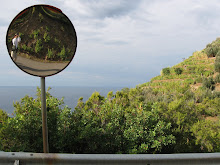We've been known to invite complete strangers into our home, actually, not complete strangers, I mean, how complete a stranger could an Appalachian through-hiker be? To some people they might seem strange or irresponsible, but to us, they seem, maybe, adventurous, energetic, thoughtful, perhaps even wild or romantic.
What's the worst that could happen? They're not going to steal much. After all, they've chosen to hike 2100 miles with a backpack and by the time they get to Virginia they've learned to keep that pack as light as possible.
"Stink up your washing machine for a month?" Virginia offers. Yes, Karen would probably agree with that.
What's the best that could happen? They might become friends. Several have returned after summiting Mt. Kathadin. One fellow came back yet another time to house-sit while we spent a month in Italy, and again after that. Our current guest is a through-hiker friend of a through-hiker friend of our house-sitter, who stayed here 2 years ago during his own walk in the woods. He's helping Karen move pigs as I write this. I'll be the cameraman shortly.
Before the pigs, he gave me a lesson in tomatoes. He knows tomatoes because he and his dad grow tomatoes for production in Mississippi. Never put tomatoes in a refrigerator, he says. That will kill their nutritional value. Don't put them on a sunny windowsill either. They'll last longer in an open paper bag. Spreading them apart is a good idea because the more they're exposed to the ethylene gas they put off, the sooner they ripen. If you want a red one, put it in a paper bag with a banana. The gas from the banana will ripen it fast. (My sister will love this news, as much as she loves bananas.)
Don't they taste best when they've ripened red on the vine? Probably not, he says. Pick them when they first begin to "break red," that is, begin to turn red. Supposedly, the vine shuts down on a tomato at that stage, so there's no point leaving it on any longer. Besides, leaving it on longer might take energy from the other unripened tomatoes.
"Hmm, if the vine shuts down on it, why would that take energy from the other fruit?" asks Virginia.
Search me. Anyway, I was more interested in how to prune my tomatoes for best production. Start early, after the plant's grown a foot or so and has put out a sucker. Limit growth to two vines per plant by breaking off all but the main stem and the first sucker. As those two vines grow, continually pick off suckers. Each vine will grow three leaves, fruit, three leaves, fruit, etc. Tie the vines up a wire or stake and train them along for as long as they'll go, sometimes 60 feet. Chickens may get the first fruit to ripen, down low, but they won't be able to reach the higher tomatoes. The fruits will ripen in order from the bottom of the vine up. As you pick them, remove the leaves below, so you basically have a bare vine up to the bottom fruits still ripening. You want the vine's energy going into the necessary leaves and fruit, not to needless leaves. The number of leaves required per vine depends on the variety of tomato; generally, 20-30 leaves is sufficient. (A "leaf" consists of a frond with all of what I previously might have called "leaves.") By the way, these instructions assume your variety is "indeterminate," which means the fruit ripens gradually from bottom up. The seed packet should say whether the seed is indeterminate or determinate. Determinate varieties, for which all the fruit ripens at the same time, are used by many commercial growers that use automated pickers.
Our friend worked on a farm in Colorado last summer. Before he came, the farmers found themselves stuck with picking green tomatoes because they couldn't get their plants to produce fast enough in their climate. With his help, they had red tomatoes for 2 months.
My work's cut out for me this Fall. Gotta get some more tomato plants in the greenhouse and see what we can do by Christmas. Maybe try the same with cucumbers. Next year, do this outdoors with tomatoes, cucumbers, vining squashes, and more.
Public Art And The Magic Eight Ball
5 months ago

Good information - especially for us city folk. I've copied it and now have it on our bulletin board in the kitchen - the fridge.
ReplyDeleteThanks, Judy